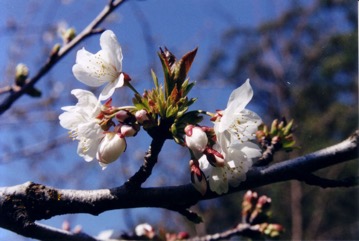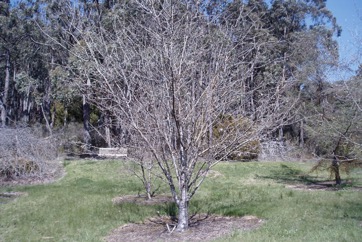Sweet cherry, Bird cherry, Wild cherry

It is a temperate plant. It is native to Europe. It can tolerate frosts except at flowering. It needs well drained soils. It needs adequate moisture during fruit development. In India it is grown between 2,000-2,500 m altitude. It needs 1,100-1,600 chilling hours below 7°C during winter. A pH of 6.5-7 is best. It suits hardiness zones 3-9.
Also known as:
Cerejeira, Cereza, Cerezo, Cerise douce, Cheresh-nya, Ciliegia dolce, Ciliegio selvatico, Cirerer bord, Cseresznye, Gean, Gilas, Kanka outou, Kiraz, Krusbal, Mazzard, Ou zhou, Siryizyi, Tian ying tao, Vadvseresznye, Vogelkirsche
Synonyms
- Cerasus avium (L.) Moench
- Cerasus avium var. aspleniifolia G. Kirchn.
- Prunus avium var. aspleniifolia (G. Kirchn.) H. Jaeger
- Prunus cerasus var. avium L.
- Prunus macrophylla Poir.
Edible Portion
- Fruit, Seeds, Leaves - flavouring, Sap
Where does Sweet cherry grow?
Found in: Afghanistan, Albania, Argentina, Armenia, Asia, Asia Minor, Australia, Austria, Azerbaijan, Balkans, Belarus, Belgium, Bosnia, Britain, Bulgaria, Canada, Caucasus, Central Asia, China, Czech, Dagestan, Denmark, Europe, France, Georgia, Germany, Greece, Himalayas, Hungary, India, Iran, Ireland, Italy, Kazakhstan, Korea, Kyrgyzstan, Lithuania, Luxembourg, Macedonia, Mexico, Moldova, Myanmar, Netherlands, North America, Norway, Pakistan, Peru, Poland, Portugal, Romania, Russia, San Marino, Scandinavia, Serbia, Slovakia, Slovenia, South America, Spain, Sweden, Switzerland, Tasmania, Turkey, Ukraine, United States, Yugoslavia
Notes: There are about 200 Prunus species.
Status: It is a cultivated food plant.
Growing Sweet cherry, Bird cherry, Wild cherry
Cultivation: Seeds need to be treated with cold by putting in a refrigerator for 3-4 months before sowing. They should be sown 5 cm deep. They may still take a year to germinate. Seedlings can be budded from better fruuting trees. Tongue grafting is used. Larger fruit often lack flavour. It requires cross pollination so 2 or more cultivars are planted together. Suitable pollinating varieties have to be chosen. A spacing of 4 m is suitable. Trees are pruned to produce 4 or 5 widely spaced branches. Bearing trees need little pruning. Fruit are produced on spurs of one year old wood. These can produce for 10-12 years.
Edible Uses: The fruit are eaten raw. They are also used for jam. They are also dried, stewed, used in pies, cakes, ice cream and pastries. They can be made into preserves or jelly. Liqueurs are distilled from the fermented pulp. The stones were also crushed into the pulp. Candied cherries are used in cakes and puddings. The leaves are added to pickled cucumbers, apples and tomato for flavouring. The leaves are used for sarma in Turkey. They are rolled around a filling of rice or minced meat. The gum from the bark can be eaten. It is allowed to solidify and eaten as a children's snack.
Production: Trees produce in 3-4 years. Trees last about 45 years. Fruit are hand picked when ripe. A tree can produce 18-20 kg of fruit.
Nutrition Info
per 100g edible portion| Edible Part | Energy (kcal) | Protein (g) | Iron (mg) | Vitamin A (ug) | Vitamin c (mg) | Zinc (mg) | % Water |
|---|---|---|---|---|---|---|---|
| Fruit | 72 | 1.2 | 0.4 | 21 | 7 | 0.1 | 80.8 |
Sweet cherry, Bird cherry, Wild cherry Photos


References
Abbet, C., et al, 2014, Ethnobotanical survey on wild alpine food plants in Lower and Central Valais (Switzerland). Journal of Ethnopharmacology 151 (2014) 624–634
Ambasta, S.P. (Ed.), 2000, The Useful Plants of India. CSIR India. p 494
Bianchini, F., Corbetta, F., and Pistoia, M., 1975, Fruits of the Earth. Cassell. p 146
Bodkin, F., 1991, Encyclopedia Botanica. Cornstalk publishing, p 840
Bonet, M. A. & Valles, J., 2002, Use of non-crop food vascular plants in Montseny biosphere reserve (Catalonia, Iberian Peninsula). International Journal of Food Sciences and Nutrition (2002) 53, 225–248 (As var. sylvestris)
Brickell, C. (Ed.), 1999, The Royal Horticultural Society A-Z Encyclopedia of Garden Plants. Convent Garden Books. p 836
Bussman, R. W., et al, 2016, A comparative ethnobotany of Khevsureti, Samtskhe-Javakheti, Tusheti, Svaneti, and Racha-Lechkhumi, Republic of Georgia (Sakartvelo), Caucasus. Journal of Ethnobiology and Ethnomedicine.
Bussman, R. W. et al, 2017, Ethnobotany of Samtskhe-Javakheti, Sakartvelo (Republic of Georgia), Caucasus. Indian Journal of Traditional Knowledge Vol. 16(1) pp 7-24
Cerne, M., 1992, Wild Plants from Slovenia used as Vegetables. Acta Horticulturae 318
Chandrashekara, U. M., 2009, Tree species yielding edible fruit in the coffee-based homegardens of Kerala, India: their diversity, uses and management. Food Sec. 1:361-370
Cheifetz, A., (ed), 1999, 500 popular vegetables, herbs, fruits and nuts for Australian Gardeners. Random House p 222
Coombes, A.J., 2000, Trees. Dorling Kindersley Handbooks. p 258
Cundall, P., (ed.), 2004, Gardening Australia: flora: the gardener's bible. ABC Books. p 1092
Dashorst, G.R.M., and Jessop, J.P., 1998, Plants of the Adelaide Plains & Hills. Botanic Gardens of Adelaide and State Herbarium. p 74
Denes, A., et al, 2012, Wild plants used for food by Hungarian ethnic groups living in the Carpathian Basin. Acta Societatis Botanicorum Poloniae 81 (4): 381-396 (As Cerasus avium)
Dogan, Y., et al, 2015, Of the importance of a leaf: the ethnobotany of sarma in Turkey and the Balkans. Journal of Ethnobiology and Ethnomedicine, 11:56
Dzhangaliev, A. D., et al, 2003, The Wild Fruit and Nut Plants of Kazakhstan, Horticultural Reviews, Vol. 29. pp 305-371
Ertug, F, Yenen Bitkiler. Resimli Türkiye Florası -I- Flora of Turkey - Ethnobotany supplement (As Cerasus avium)
Esperanca, M. J., 1988. Surviving in the wild. A glance at the wild plants and their uses. Vol. 2. p 324
Farrar, J.L., 1995, Trees of the Northern United States and Canada. Iowa State University press/Ames p 375
Fl. suec. ed. 2, 165. 1755
Flora of China @ efloras.org Volume 9
Flowerdew, B., 2000, Complete Fruit Book. Kyle Cathie Ltd., London. p 48
Glowinski, L., 1999, The Complete Book of Fruit Growing in Australia. Lothian. p 67
Gouldstone, S., 1983, Growing your own Food-bearing Plants in Australia. Macmillan p 88
Harris, E & J., 1983, Field Guide to the Trees and Shrubs of Britain. Reader's Digest. p 100
Hedrick, U.P., 1919, (Ed.), Sturtevant's edible plants of the world. p 521
Heywood, V.H., Brummitt, R.K., Culham, A., and Seberg, O. 2007, Flowering Plant Families of the World. Royal Botanical Gardens, Kew. p 282
Hibbert, M., 2002, The Aussie Plant Finder 2002, Florilegium. p 241
http://nordicfood lab/org/blog/2102/9/wild-edible-plants-an-overview
Hu, Shiu-ying, 2005, Food Plants of China. The Chinese University Press. p 442
INFOODS:FAO/INFOODS Databases
Irving, M., 2009, The Forager Handbook, A Guide to the Edible Plants of Britain. Ebury Press p 270
Jackes, D. A., 2007, Edible Forest Gardens
Janaćković, P. et al, 2019, Traditional knowledge on plant use from Negotin Krajina (Eastern Serbia): An ethnobotanical study. Indian Journal of Traditional Knowledge Vol 18 (1), pp 25-33
John, L., & Stevenson, V., 1979, The Complete Book of Fruit. Angus & Robertson p 104
Joyce, D., 1998, The Garden Plant Selector. Ryland, Peters and Small. p 117
Kermath, B. M., et al, 2014, Food Plants in the Americas: A survey of the domesticated, cultivated and wild plants used for Human food in North, Central and South America and the Caribbean. On line draft. p 710
Khan, D. & Shaukat, S.S., 2006, The Fruits of Pakistan: Diversity, Distribution, Trends of Production and Use. Int. J. Biol. Biotech., 3(3):463-499
Kiple, K.F. & Ornelas, K.C., (eds), 2000, The Cambridge World History of Food. CUP p 1751
Kizilarslan, C. & Ozhatay, N., 2012, An ethnobotanical study of the useful and edible plants of İzmit. Marmara Pharmaceutical Journal 16: 134-140, 2012.
Lazarides, M. & Hince, B., 1993, Handbook of Economic Plants of Australia, CSIRO. p 199
Little, E.L., 1980, National Audubon Society Field Guide to North American Trees. Alfred A. Knopf. p 495
Luczaj, L., 2012, Ethnobotanical review of wild edible plants of Slovakia. Acta Societatis Botanicorum Poloniae 81(4):245-255
Łukasz Łuczaj and Wojciech M Szymański, 2007, Wild vascular plants gathered for consumption in the Polish countryside: a review. J Ethnobiol Ethnomedicine. 3: 17
Luczaj, L., et al, 2015, Wild food plants and fungi used by Ukrainians in the western part of the Maramureş region in Romania. Acta Soc Bot Pol 84(3):339–346
Mabey, R., 1973, Food for Free. A Guide to the edible wild plants of Britain, Collins. p 171
Menendez-Baceta, G., et al, 2012, Wild edible plants traditionally gathered in Gorbeialdea (Biscay, Basque Country) Genetic Reources and Crop Evolution 59:1329-1347
Pardo-de-Santayana, M., et al, 2005, The gathering and consumption of wild edible plants in the Campoo (Cantabria, Spain). International Journal of Food Sciences and Nutrition. 56(7): 529-542
Pieroni, A., 1999, Gathered wild food plants in the Upper Valley of the Serchio River (Garfagnana), Central Italy. Economic Botany 53(3) pp 327-341
Pieroni, A.,& Giusti, M. E., 2009, Alpine Ethnobotany in Italy: Journal of Ethnobiology and Ethnomedicine. 5:32
Pieroni, A., 2008, Local plant resources in the ethnobotany of Theth, a village in the Northern Albanian Alps. Genet Resour Crop Evol (2008) 55:1197–1214 (As Cerasus avium)
Plants for a Future database, The Field, Penpol, Lostwithiel, Cornwall, PL22 0NG, UK. http://www.scs.leeds.ac.uk/pfaf/
Polunin, O., & Stainton, A., 2006, Flowers of the Himalaya, Oxford India Paperbacks. p 115
Postman, J. D., et al, 2012, Recent NPGS Coordinated Expeditions in the Trans-Caucasus Region to Collect Wild Relatives of Temperate Fruit and Nut Crops. In Acta Horticulturae Number 948 p 191-198
Redzic, S. J., 2006, Wild Edible Plants and their Traditional Use in the Human Nutrition in Bosnia-Herzegovina. Ecology of Food and Nutrition, 45:189-232
Redzic, S., 2010, Use of Wild and Semi-Wild Edible Plants in Nutrition and Survival of People in 1430 Days of Siege of Sarajevo during the War in Bosnia and Herzegovina (1992–1995). Coll. Antropol 34 (2010) 2:551-570
Sansanelli, S., et al, 2014, Wild food plants traditionall consumed in the area of Bologna (Emilia Romagna region, Italy). Journal of Ethnobiology and Ethnomedicine 10:69
Schunko, C., et al, 2010, Organic farmers use of wild food plants and fungi in a hilly area in Styria (Austria). Journal of Ethnobiology and Ethnomedicine 6:17
Segura, S., et al, 2018, The edible fruit species in Mexico. Genet Resour Crop Evol (2018) 65:1767–1793
Sfikas, G., 1984, Trees and shrubs of Greece. Efstathiadis Group. Athens. p 70
Sharma, B.B., 2005, Growing fruits and vegetables. Publications Division. Ministry of Information and broadcasting. India. p 35
Small, E., 2009, Top 100 Food Plants. The world's most important culinary crops. NRC Research Press. p 169
Svanberg, I. et al, 2012, Uses of tree saps in northern and eastern parts of Europe. Acta Societatis Botanicorum Poloniae 81 (4): 343-357
Tardio, J., et al, Ethnobotanical review of wild edible plants in Spain. Botanical J. Linnean Soc. 152 (2006), 27-71
USDA, ARS, National Genetic Resources Program. Germplasm Resources Information Network - (GRIN). [Online Database] National Germplasm Resources Laboratory, Beltsville, Maryland. Available: www.ars-grin.gov/cgi-bin/npgs/html/econ.pl (10 April 2000)
van Wyk, B., 2005, Food Plants of the World. An illustrated guide. Timber press. p 306
Vasquez, R. and Gentry, A. H., 1989, Use and Misuse of Forest-harvested Fruits in the Iquitos Area. Conservation Biology 3(4): 350f
Vlkova, M., et al, 2015, Edible Plants Sold on Marginal Rural Markets in Fergana Valley, Southern Kyrgyzstan. Bulgarian Journal of Agricultural Science, 21 (No 2) 2015, 243–250
Watkins, R., 1979, Cherry, plum, peach, apricot and almond, in Simmonds, N.W., (ed), Crop Plant Evolution. Longmans. London. p 242
World Checklist of Useful Plant Species 2020. Royal Botanic Gardens, Kew
www.efloras.org Flora of China Volume 9 (As Cerasus avium)